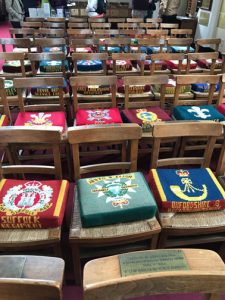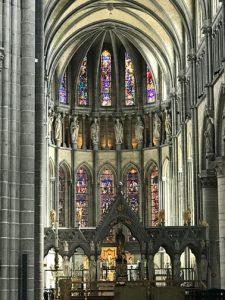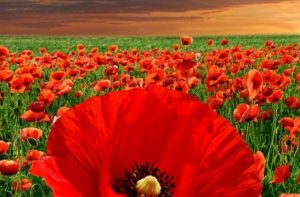Thursday, May 11, 2017
Antwerp to Bossuit for disembarkation to travel by coach to Ypres, then by coach back to Oodenarde (Click on map to enlarge.)
I’ll be the first to tell you that history is not my best subject. I love that my sons light up when historical facts are discussed. But I don’t share their enthusiasm. However, I do believe that history is important. George Santayana, Spanish-American scholar, famously wrote, “Those who cannot remember the past are condemned to repeat it,” in the five-volume “The Life of Reason” (1905-6). That statement, written ten years before the battles at Ypres, was important at that time, but ever so much more important in the current administration in the United States.So, along with many of my shipmates, I headed to Ypres, Flanders, Belgium, to visit the “In Flanders Fields” Museum and learn more about what happened in Belgium—and, specifically, Ypres—during those bombings.
The information sheet given to us by Avalon before our excursion stated,
No visitor to Ypres nowadays can imagine that this vibrant, lively city with its splendid Renaissance and Medieval architecture was razed to the ground at the end of the Great War. Yet Ypres rose from the ashes like a phoenix. Based on old photos and plans, the buildings were restored stone by stone and now shine with new lustre. Memories of the futile and devastating battles that ravaged Flanders are preserved to this day, however, in museums, in the moving ceremony of “The Last Post” at the Menin Gate, and in the many cemeteries and memorials in the area.
Walking into the town through the Menin Gate Memorial, we soon came into the Grote Markt (Market Square), flanked by the Cloth Hall. The Cloth Hall was originally built in the 13th century. Its original purpose was for storage and shipment of textiles. After its destruction in 1914-1915, it was rebuilt true to the original. It is now the home of the “In Flanders Fields” Museum.
It’s difficult to fully describe this museum. You cannot imagine its effect on the visitor until you are a visitor there. The designers used moving video projections, unique sound fragments, and modern multimedia applications to create an environment that immerses the visitor in life on the front line. Here is the link to the museum’s website. On The Great War site is another informative page.
I was, of course, most interested in looking at the samples and examples of the uniforms the various countries’ soldiers wore, and the implements that these men (and, in some cases, women) used in their daily lives. But after a while, the sadness of the museum and the dirge-like music that accompanied and underscored the music felt to me like just too much to take.
I went downstairs to the dining area and waited for the others to finish and for lunch to be served. After lunch, our guide took us to see more must-be-remembered sites.
 We started with St. George’s Memorial Church. This church was built by the British Veterans’ Association in memory of the more than 250,000 British and Commonwealth soldiers. Again, from The Great War site, more information about this church. I loved examining the cushions on each chair. Each one was needlepointed by hand in honor of a group who fought—and, most likely, died—to defend freedom.
We started with St. George’s Memorial Church. This church was built by the British Veterans’ Association in memory of the more than 250,000 British and Commonwealth soldiers. Again, from The Great War site, more information about this church. I loved examining the cushions on each chair. Each one was needlepointed by hand in honor of a group who fought—and, most likely, died—to defend freedom.
 Next we visited St. Martin’s Cathedral. Heavily damaged in the war, between 1922 and 1930, the church was leveled and rebuilt following the original plans. Here’s a page from The Great War site that includes information about the rebuilding of the entire town, along with St. Martin’s.
Next we visited St. Martin’s Cathedral. Heavily damaged in the war, between 1922 and 1930, the church was leveled and rebuilt following the original plans. Here’s a page from The Great War site that includes information about the rebuilding of the entire town, along with St. Martin’s.
To finish our tour, we visited the Menin Gate Memorial to the Missing. This was the most sobering to me of everything we had witnessed that day. The archway was built directly over the road on which hundreds of thousands of soldiers made their way directly to the front line. “Into the fire.” “Into the abyss.” The history of the gate. The gate’s walls hold the names of approximately 55,000 officers and personnel of the United Kingdom and Commonwealth Forces who died in the Ypres battles and who have no known grave. Where it was originally thought that that number accurately represented all who died, it was later learned that the number was closer to 90,000. A second wall was built in a local cemetery to list an additional 35,000 names of those whose bodies remain missing.
Some of our group had chosen to stay longer in order to experience the ceremony of “The Last Post” that takes place each evening at 8:00 at the gate. This was started in 1927 and has been played almost every night since except for a period in the Second World War when Ypres was occupied by German Forces.
The “Last Post” recording links at the bottom of the linked page in the preceding paragraph are outdated. Here is a link to a YouTube video of the “Last Post,” and there are numerous other YouTube videos you will see if you follow this link.
We chose to go back to the boat rather than stay in Ypres any longer. During our time in Ypres, the captain had repositioned from Bossuit further north to Oudenaarde, to save us time as we moved to Ghent overnight.
This was a day—these were images—never to be forgotten.
Once back onboard, it was another lovely evening of cocktails, dinner, and music—and making new friends and getting to know more about the friends we had made earlier in the week. There were lots of nice people on this cruise!








































































